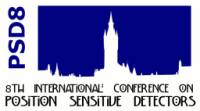Speaker
Prof.
David Smith
Description
The e2v technologies CCD54, or swept-charge device (SCD) has been extensively radiation tested for use in the Chandrayaan-1 X-ray Spectrometer (C1XS) instrument, to be launched as part of the Indian Space Research Organisation (ISRO) Chandrayaan-1 payload in 2008. The principle use of the SCD is in X-ray fluorescence (XRF) applications, the device providing a relatively large collecting area of 1.1 cm2, and achieving near Fano-limited spectroscopy at -15oC, a temperature that is easily obtained using a thermoelectric cooler (TEC). This paper describes the structure and operation of the SCD and details the methodology and results obtained from two proton irradiation studies carried out in 2006 and 2008 respectively, to quantify the effects of proton irradiation on the operational characteristics of the device. The analysis concentrates on the degradation of the measured FWHM of various elemental lines and quantifies the effects of proton fluence on the observed XRF spectra from mineralogical target samples.
Author
Prof.
David Smith

